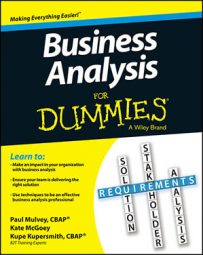A solution (or product) position statement is a description and positioning of a specific solution approach in a business analysis. It generally follows the format of “For the target audience of U who need V, the new product W is a solution that will do X. Unlike alternative Y, our solution does Z.”
An important element of a good solution is that it solves a real problem worth solving and ultimately provides value back to the audience using the solution. That task may sound simple, but it can be challenging. Therefore, use the problem statement and the solution position statement together to validate the value.
One reason to create a solution position statement is to explain the proposed solution to leaders; it makes a great elevator speech, with all the points summarized clearly and succinctly. But solution position statements also align all the project stakeholders toward the project goals and objectives.
By clearly articulating what you’re creating, what you ultimately intend to provide or sell, and to whom (as well as why they’d be compelled to use it), you can create incredible clarity around the team’s objectives and delivery goals. This clarity appropriately drives requirements definition and prioritization.
The problem statement characterizes the issue and what the right solution must have to solve the problem, but after your team decides which way is best to solve the problem specifically, you must characterize your choice with a solution position statement. Describe what the specific solution is and explain why, given these custom features and design, it is in fact (once complete) the right solution to meet the need.
If you’ve never created a solution position statement, use the following framework:
“For [target audience] . . .” State the target user, market, or customer by naming its role or characterizing its group.
“ . . . who [statement of the need or opportunity] . . .” Describe what the target is trying to achieve or do while it’s having the problem. Rather than state the problem directly, state the need your target audience will have the opportunity to meet.
“ . . . the [name of new product or business] is a [solution or business category] . . .” Set the context for the solution by portraying the kind of product, solution, or new business venture (if pursuing large opportunities) it is. State the category the solution belongs to so the audience members understand its relevance and relationship to their needs.
“ . . . that [statement of key benefit — the compelling reason to use the solution or do business with you].” Highlight what the solution offers that will motivate or most interest the audience. This piece is the must-have outcome of value — the persuasive benefit. Provide the reason why this solution is the right solution by stating how the solution meets the need.
“Unlike [primary competitive alternative] . . .” If the target didn’t have your solution, what solution(s) may it look for or consider instead? State the current environment or competitor products to beat, or internally, the unacceptable situation (what the company has now) to fix.
“ . . . our product [statement of primary differentiation].” Distinguish and sell the solution. Besides the fact that it meets the most critical need, what other interesting or attractive features are included? List key marketing points or functionality that addresses the problem statement. Establish why stakeholders would want or need this function. What sets it apart? What are the key differentiators?
When developing solution position statements, speak to your market’s need, not your business’s need and then align the features and functions closely to that positioning. Don’t add bells and whistles to a solution if they don’t make sense for its purpose, or you’ll waste time on things that don’t add value.
An effective solution position statement may be something like the following:
For our visiting customers who don’t appreciate secondhand smoke, hotel rooms that stink, or smoke-damaged linens and furniture, the no-smoking policy is a new policy for our hotel and guests that prohibits smoking in all our U.S. hotel rooms to address customer experience and our occupancy decline.
Unlike our current policy, which allows smoking in some rooms, this solution will eliminate the impact of cigarette smoke in our rooms and on our customers, provide a cleaner environment for our guests and staff, and increase guest satisfaction with our hotel and customer service policies.
Notice how this solution statement concentrates on the benefits realized for the guests, not housekeeping. The solution statement for housekeeping would concentrate on the savings realized by spending less time cleaning the rooms in between guests.

